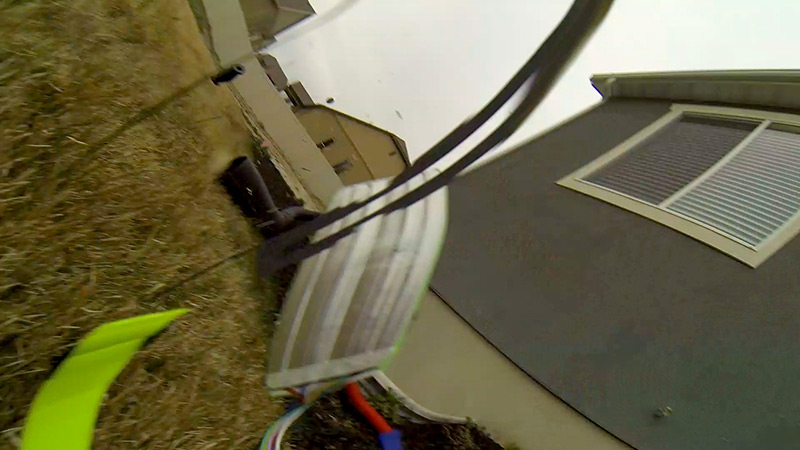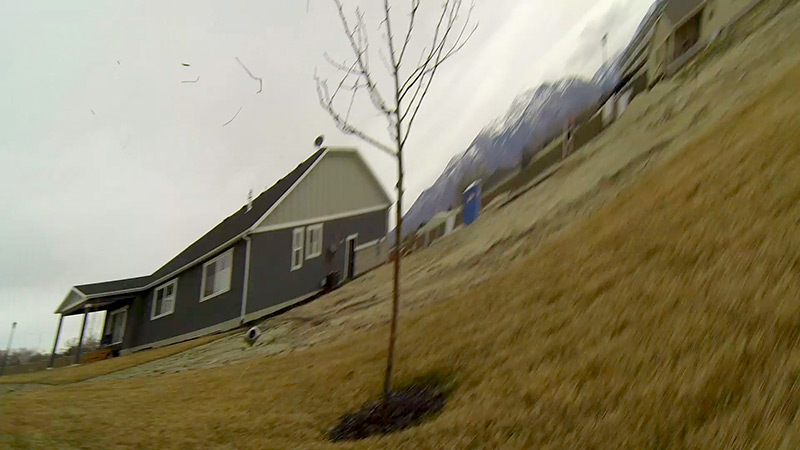

I’ve been semi-happily flying this new Alien H4 680mm quadcopter build. I say semi-happily because I’ve been in jello hell, trying to get rid of the video vibrations and wobbles. That, and the new landing gear I installed included one unit which was defective.
I spent a week (not 24/7 but you get the concept) balancing props and motors (motor balancing video coming soon) and reduced the overall vibrations quite a bit. I was out flying over a construction area, where there’s some open dirt and a few unoccupied homes being built. I was testing to see if I’d gotten rid of the GoPro jello effect.
That’s what I made a mistake that I was not aware of until it was too late. Suddenly the bird started to nosedive.
It crashed in some very soggy sod behind one of the new houses. One arm and prop was so impaled, it took almost all my strength to get the arm out of the ground. There was quite a bit of damage, though mostly small and inexpensive parts totaling up to about $120.00. The cost could have been far worse. The hours it will take to get it repaired, after waiting for parts from China, is the real pain.
The Mistake
Fortunately the MiniX flight controller keeps a log. That way I could look at it to see if any information could help me diagnose the cause of the crash. The log showed me some good news and bad news. The good news was that the crash was not due to any kind of equipment failure. The bad news was that it was user error.
I unknowingly had flipped into manual mode, thinking I had flipped to GPS mode. At 177 feet the props stopped spinning enough to keep the bird airborne. Seven pounds of carbon fiber, metal, and plastic hits the ground in about two seconds from that distance. No time to react.
I couldn’t believe the log and that I’d been such an idiot flipping to manual. A look at the switch on the remote confirmed MY error.
Solution
I never fly manual and I don’t intend to with this, or any of my copters. I don’t do trick flying. My ships are for aerial photos and video. I plan to either disable the manual switch (not the best idea in case of emergency when GPS fails or somesuch thing), or set my remote to delay 5-10 seconds and produce an audible “manual mode will activate in five seconds” type of thing.
Below are a few stills from the crash video.

Battery ejected on impact. Velcro straps shaved off with razor precision. Gimbal vibration ball on left flying through the air. Long rectangular donut-shaped item is one of the gimbal control board box’s side panels, about .5 inches wide and 2 inches long. It must be right in front of the GoPro lens.

FPV camera left of tree points back. Too bad it was unplugged and not recording the view looking back toward the GoPro..
Winter is in full force here with plenty of snow and very cold temperatures. I’ve been working on fine tuning the settings for my large hexacopter (six propeller drone) this year, and when the snow and cold hit I saw that as an opportunity to capture some “winter” themed video and photos for my demo reel. The cold temperatures threw all sorts of monkey wrenches into that idea.
How Cold Temperatures Affect Drones
Drones are highly technical machines with motors, sensors, tight tolerances. The cold temperatures can affect the sensors such as the gyroscope and accelerometers, causing them to misbehave or produce unexpected results. This can affect the flight characteristics of the bird.
Camera gimbals, which are used to keep cameras level or smooth out motion, also have these types of sensors. Cold temperatures can cause gimbals to perform differently than they would in warmer temperatures. One way to try and get around these issues is to calibrate the sensors in the same cold temperatures, not in the warmth of the shop.
Batteries can be greatly affected by the cold. There’s a reason why Sears advertised that their Die Hard car batteries performed in extreme winter conditions, because cold can reduce battery performance. Cold temperatures typically translate to shorter flight times. This is very important to keep in mind for those who time flights rather than keeping an eye on battery voltage. I’ve found that in very cold temperatures the voltage drops quickly at first, but does level out a bit toward the end of the flight.
Brittle parts can be a problem. If there are parts of the drone which need to be tightened before flight, doing so in the cold could result in easy breakage. For instance, the arms on my hexacopter are foldable. I make sure they’re tightened down in the warmth of my house and that I don’t tighten them down outside in the cold. Hard landings in the cold with more brittle parts could mean more damage to the bird in a crash.
Lastly, the pilot can be greatly affected by the cold. While flying yesterday in 12 degree fahrenheit temperatures, my bare fingers were numb about five minutes into the first battery set. Numb fingers can be a very bad thing when the feel of the controls on the remote is so important. With a numb thumb I could easily bump the throttle down and not feel that I’ve done so. A bad bump could mean reducing thrust enough that the bird falls from the sky, or perhaps a bump up in throttle might turn the bird into a kamikaze.
Air Density
Cold temperatures mean higher air density. This can change the flight characteristics of the drone. With higher air density the same propellor RPMs produces more lift. The motors will not have to work as hard, which could be a positive or a negative depending on the setup. Usually it is a positive though, producing slightly smoother flight and working the setup a little less.
Entertaining video. I hope I’m not in one of these. My favorite spots are 14:30 and 23:05.